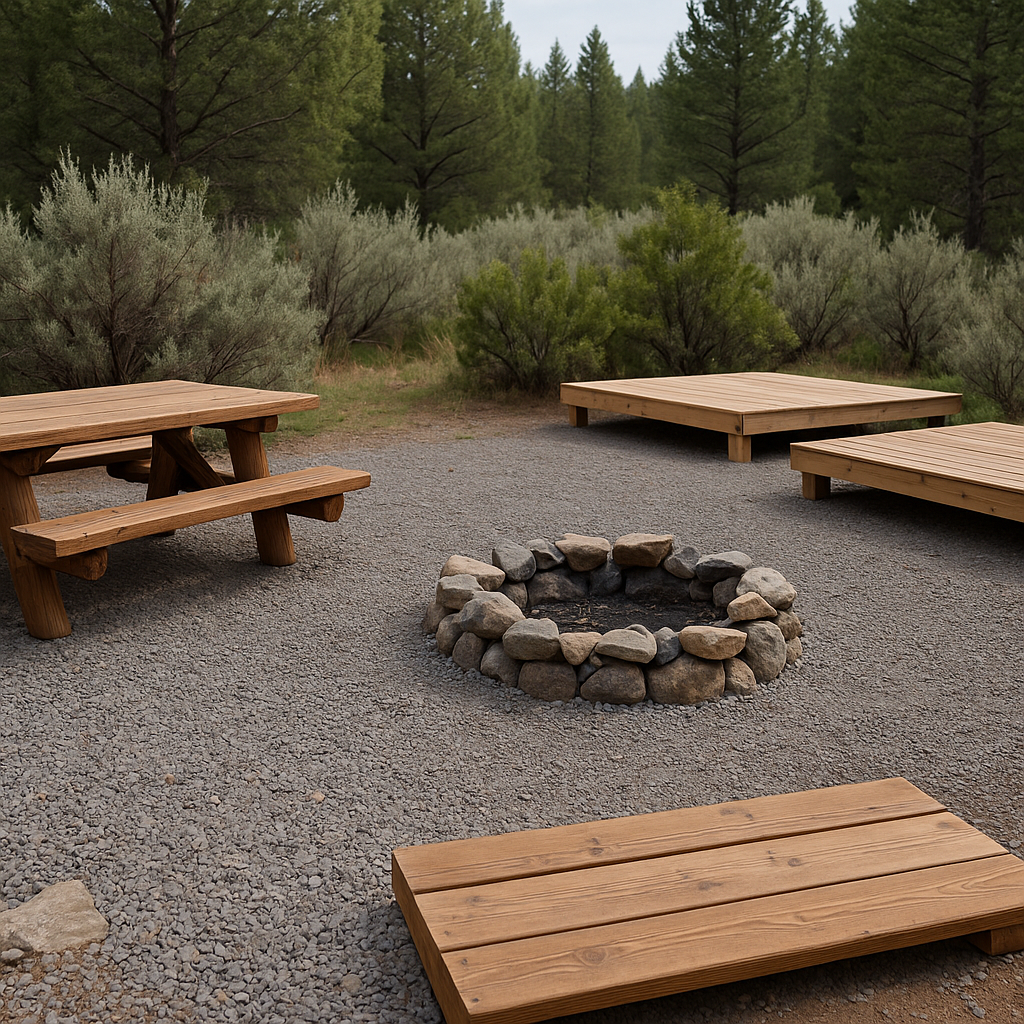Building a Campsite That Respects the Land
Designing a low-impact campsite is about finding balance. You want a comfortable, practical setup without disrupting the natural environment that makes your land so special. Recreational properties across Utah offer open terrain, sagebrush, pines, and rock shelves that are already part of a perfect outdoor setting. The key is to work with those features rather than against them.
Begin by studying your land’s contours, drainage, and vegetation. Look for naturally clear or lightly vegetated areas where minimal clearing is needed. Avoid slopes, flood zones, and spots with soft soil or fragile plant life. If your land includes trees, use them as shade and windbreaks instead of cutting them down. The goal is to preserve your land’s integrity so it remains healthy and usable for decades.
Choosing Materials and Structures That Blend In
Using the right materials and design elements can make your campsite durable, attractive, and sustainable.
Use gravel or compacted soil for paths and gathering areas. Gravel helps with drainage, prevents mud, and avoids the need for concrete or asphalt. When you use native or neutral-colored stone, your site blends seamlessly with the landscape. Over time, these pathways require very little upkeep, even with heavy use from vehicles or foot traffic.
Select untreated wood, stone, or metal for long-lasting camp features. Instead of pressure-treated lumber or plastic tables, choose materials that naturally weather well outdoors. Rough-cut timber, reclaimed wood, or local stone can be used for seating, fire pit rings, or cooking surfaces. These options resist rot and don’t leach chemicals into the soil. They also create a rustic, authentic feel that suits recreational land in Utah’s high country.
Build raised platforms or pads for tents and shelters. Elevating tents or small structures helps with water runoff and soil protection. Platforms made from natural wood or recycled composite decking provide comfort while reducing compaction and erosion. They also make your setup easier to maintain if you plan to camp often or host guests.
Add natural windbreaks with native vegetation. Planting shrubs, sagebrush, or small pines along the edges of your site helps block wind, reduce dust, and stabilize loose soil. This not only improves comfort during camping but also helps protect your land from erosion. Over time, these plants become part of the landscape, making your campsite feel more secluded and peaceful.
Managing Water and Waste Responsibly
Water and waste systems are often overlooked in campsite design, but they play a major role in sustainability. Poor drainage or careless waste disposal can quickly damage your property or contaminate water sources.
Designate a gray water disposal area away from creeks or ponds. Use a gravel bed or small trench to disperse dish and shower water safely. This allows water to filter naturally through the soil without pooling or creating muddy spots. Always use biodegradable soap and cleaning products so you don’t harm vegetation or soil health.
Install a composting or portable waste system. A composting toilet or sealed portable option can be simple and odor-free when managed properly. This prevents contamination and keeps your property clean for future use. If you’re using your land for group camping or longer stays, building a small, enclosed waste area can also add comfort and convenience.
Control stormwater runoff with trenches or swales. During rain, natural slopes can direct water toward tents or camp areas. Dig shallow trenches to redirect it, or build simple rock berms to slow it down. This protects the soil from washing away and helps your campsite remain stable during heavy storms.
By planning your water and waste systems early, you create a campsite that will stay functional for years without harming your surroundings.
Keeping Fire Safety and Land Health in Mind
Utah’s dry climate means fire safety should always be part of campsite design. A good layout protects both your property and the surrounding wilderness.
Build a well-defined fire pit with stone or metal edging. Clear at least 10 feet of space around it, removing grass, branches, and debris. This creates a controlled area for safe cooking and campfires. Using local rock for the fire ring helps it blend in naturally with your property.
Rotate tent and vehicle areas periodically. Over time, heavy use can compact the ground and damage vegetation. By changing up where you set up camp, you allow grass and soil to recover naturally. This helps prevent erosion and keeps your site looking fresh and healthy.
Store firewood and equipment neatly in one area. Designate a covered spot for tools, chairs, and wood piles to avoid clutter and protect materials from the weather. A tidy, organized layout helps reduce long-term wear and keeps wildlife from disturbing your supplies.
Enjoying and Preserving Your Recreational Property
A low-impact campsite does more than provide a place to sleep. It gives you a long-term outdoor retreat that grows better with time. When your campsite is designed with care, you’ll spend less effort fixing erosion, clearing brush, or replacing damaged materials. Instead, you’ll enjoy peaceful weekends, family gatherings, and quiet mornings surrounded by Utah’s natural beauty.
Sustainability is about more than protecting the land; it’s about making sure your space remains enjoyable and functional for future generations. By blending good design, practical materials, and respect for the environment, you can create a low-impact campsite that lasts, and that truly feels like part of the land you love.


